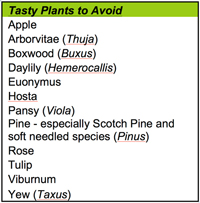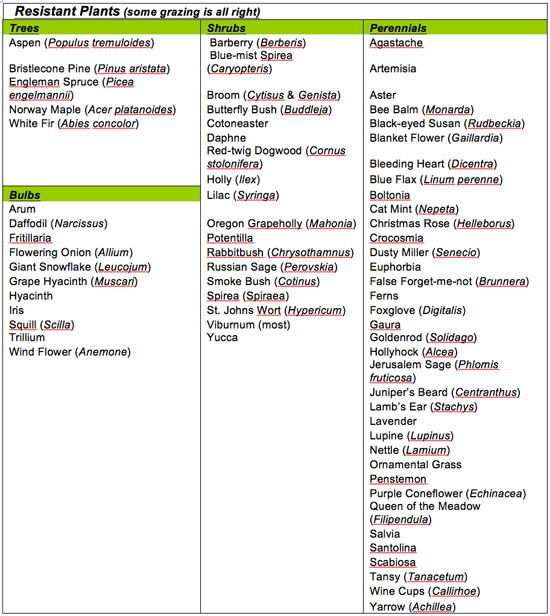Mule Deer
Gardening Information
The mule deer, Odocoileus hemionus hemionus, is a beautiful animal that many of us come into contact with any time we are out of doors. It doesn’t matter if we are in the mountains, foothills, or our own yard. Usually we marvel at their speed and agility, but their appetite for our flowers can lead to conflict for both deer and gardener. While there isn’t a perfect solution, there are many efforts, that when combined, can keep you gardening and deer deterred.
Mule deer are migratory, depending on the season and food supply. They spend much of the summer in higher mountainous areas and move to lower elevations in the winter to avoid deep snow. This means that they will be most active in your yard from December to April, depending on where you live. Homes located in foothills, inside these natural migratory ranges, can expect more damage. Winter/spring, therefore is the prime time of year to apply repellents.
Damage Characteristics
Sometimes it can be difficult to tell exactly what is causing plant damage, so here are some tips; Mule deer are browsers, which means they nibble on a variety of plants; they primarily graze on shrubs and twigs and occasionally grasses. Deer have no upper teeth, so they rip food rather than cut it in clean lines, leaving a jagged edge or torn surface on twigs and stems. Whole plants will generally not be consumed as the deer graze on tips of plants while wandering from one plant to another. Young plants may be uprooted as deer attempt to tear off their tips. They can be surprisingly adept at eating off the sweet flowers and leaving the rest of the plant alone.
Plant Selection
Just like us, deer have a preferred palate of plants they like to eat; by leaving these plants out of our gardens we can minimize much of the conflict. There are also many plants that actually prefer a nibble from a deer now and then and can save you the work of pruning.


Barriers
Because of their nimble legs, it can be difficult to keep deer out completely, however even a small fence can slow them down. A realistic fence height for the home garden would be 6-8 feet; for a more complete exclusion 10-12 feet is a better range. The material of the fence seems to make little difference as long as it is easily maintained.
Bird netting, laid over the top flowerbeds and pinned down, is very effective. Spring pansies and tulips can really benefit from being covered. While sometimes unsightly, it protects all the blossoms underneath and is relatively inexpensive. Care must be taken in the springtime to cut holes in the net allowing new flowers to push through without being hindered.
Wrapping your soft evergreens with burlap sheets in the wintertime can offer very good protection. While it may look a little whimsical, it works very well, and also prevents limb breakage from snow. Comparing wrapped and unwrapped trees here at Red Butte Garden were like night and day by springtime; the wrapped tree was not consumed at all while the other was completely eaten.
Scare Tactics
Deer are easily startled, but they are not easily fooled. Motion activated sprinklers, lights, or noises are all great at getting the deer’s attention, but they usually don’t scare them off completely.
Repellents
There are a number of products on the market that claim to stop deer from eating plants. Their ingredients range from garlic and eggs to chemicals like thiram. Recently, several studies have clarified some of the better ones. All repellents show better protection than using nothing at all. The largest factor for effectiveness was how hungry the deer were and how often the repellent was applied. Here are a few of the better products:
The use of predator urines as a deterrent have recently gained a lot of attention. They work, are easily applied, and are reasonably priced. Small amounts are poured into a dispenser jar and hung near the plant. Each dispenser covers approximately 12 feet. Place the dispensers in the fall and put out a fresh dose 2 months later.
Ammonium soaps are sold under many names, but essentially are all the same. Some brand names include Big Game Repellant or BGR, Rockland Hinder, Fertilome Rabbit & Deer Repellant. They work by taste and odor and can be easily washed off. Because of this, they are good to use on edible plants, but must be re-applied more often. While the scent is offensive to deer, most people aren’t bothered.
Garlic oils work by odor and are recommended by several studies. The brand name Bobbex® seems to do particularly well. Although it is very good for food crops, it doesn’t last in snowy and wet weather because the scent is suppressed.
Egg solids are the most popular ingredient in repellents. The scent isn’t very offensive to us, but the sensitive noses of deer can pick it out. It is a quite safe to use and lasts a few months because of its stickiness.
Denatonium benzoate or bitrex, or thiram-based products are both highly recommended. They are liquids that are applied to the leaves and stems of plants. The advantage of these products is that they stay on the plant longer lessening re-application time.
Products containing Benzyldiethyl ammonium saccharide .065% and thymol .35% provided little protection and are not recommended. Methods such as hanging bars of soap and spreading human hair are not recommended>/u>. Both require a significant amount of time and material. Human hair usually works for only a few days and can be very unsightly. Mints and blood, bone, or meat meals are also very poor protectors. Pepper or capsaicin has shown some effectiveness, but performed better for squirrels and rabbits than deer.
Deer are the most influential non-domesticated grazer in our area, because they eat grasses down to the ground in some areas but not others. This creates more diversity in the plant community by providing opportunities for other grass, flowers or tree seedlings to take root in bare spaces. Their tip grazing also provides a natural pruning keeping plants compact.
Understanding and appreciating the role of deer in nature can soften the blow of losing your favorite daylily flower. With these tips and a little luck, hopefully we can all get along.
Article by Michelle Cook




